
Finding Focus in the Chaos of Work
In our fast-paced work environments, distractions are often viewed as obstacles to productivity. Yet, innovative mindfulness training proposes a counterintuitive approach: embracing these distractions to enhance focus. This approach, described by mindfulness teacher Toby Sola, introduces a unique meditation practice designed specifically for the busy professional.
Understanding the Concentration Algorithm
During a recent guided meditation practice, Sola introduces what he calls the "concentration algorithm." This technique encourages individuals to focus on what distracts them rather than avoiding it. Why would one want to train their attention on distractions? The answer lies in the nature of human cognition. By tuning in to distractions—such as sounds, thoughts, or emotional sensations—we learn to refine our focus, molding our attention like a sculptor shapes clay.
Actionable Insights: Shifting Attention
At its core, this practice involves checking in with oneself. Sola guides meditators to identify their main distractions—whether they're sounds like a lawn mower or mental chatter. This self-awareness is a crucial first step. By categorizing distractions into groups—sight, sound, body sensation, and emotional states—we begin to gain control over our attention.
Mindfulness Techniques for Everyday Distractions
One of the key techniques discussed is the practice of focusing on distractions directly. For instance, if a colleague's voice becomes a distraction, rather than getting frustrated, one can learn to focus on the nuances of that sound. What does it remind you of? How does it affect your current emotional state? It's about drawing insight from the distracting stimuli surrounding us.
Utilizing Quiet Moments
Interestingly, Sola points out that when we concentrate on distractions, they sometimes dissipate as if fleeing from the attention we give them. When this occurs, instead of seeking out the distraction’s return, we can focus on the resulting silence or mental clarity. This shift to tranquility provides a pivot point, enabling deeper focus and maintaining mindfulness.
Bringing Mindfulness into the Workplace
But how can this method be effectively integrated into the workplace? For professionals accustomed to the hustle, the prospect of mindfulness may seem daunting. However, the beauty of Sola's approach is its practicality. Incorporating small moments of reflection throughout the workday—maybe while sipping coffee or during a commute—can enhance focus without overwhelming the schedule. By allowing oneself to pause and assess distractions, employees can foster resilience amid demanding tasks.
Current Trends in Workplace Mindfulness
Many organizations are beginning to understand the importance of mental well-being in enhancing productivity. Companies are offering mindfulness workshops, integrating meditation spaces, and encouraging practices that reduce burnout and workplace toxicity. Research indicates that mindfulness can reduce stress, improve emotional regulation, and enhance focus—all critical for maintaining high performance in competitive environments.
Future Predictions for Workplace Well-Being
As we look ahead, it’s clear that integrating mindfulness practices will become increasingly essential. The traditional view of productivity is shifting; the focus is now on enhancing mental health and work-life balance. It's likely that future workplaces will make resources for mental health and mindfulness even more accessible, enabling employees to manage stressors effectively while promoting focus.
By utilizing Toby Sola’s concentration algorithm, busy professionals can transform distractions into valuable insight, paving the way for a more productive and engaging work experience. Imagine a world where distractions are not interruptions but brief invitations to enhance concentration. Taking actionable steps toward incorporating such practices can lead to meaningful change, making the workplace not just a space for productivity but also one for personal growth and well-being.
 Add Row
Add Row  Add
Add 




 Add Row
Add Row  Add
Add 

Write A Comment